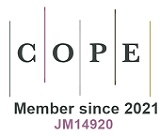Haematological Profile in Pre-Surgery Hernia Patients: A Case-Control Study in Ghana
Downloads
Introduction: The burden of hernia is disproportionately high in low-to-middle-income countries, due to the lack of fundamental resources needed to effectively diagnose and manage cases. The patterns of hernia, the haematological profile, and the predictive ability of blood cell indices were all investigated in this study. Methods: Fifty-four subjects: 27 hernia patients and 27 healthy controls were included in this single-centre, unmatched case-control study. Hernia was diagnosed using physical examination and ultrasound scan. Haematological indices of each subject were measured with an automated blood cell counter. Results: Herniae recorded were 92.59% inguinal, and 3.27% each epigastric and uterine prolapse. Hernia was prevalent in males (85.2%, p=0.008) and older subjects >=53 years (48.1%, p=0.004). HgB (p=0.006), MCHC (p<=0.001), and RDW-CV (p=0.042) levels were significantly elevated in strangulated than non-strangulated hernia and controls respectively, while Abs GRAN (p=0.024) was decreased in non-strangulated than strangulated hernia and control groups respectively. MCHC (AUC=0.947 [0.895-0.999], p<=0.001) was the most sensitive predictor for herniation followed by age (AUC=0.750 [0.610-0.889], p=0.002); HgB (AUC=0.718 [0.580-0.857], p=0.006); and RDW-CV (AUC=0.700 [0.559-0.840], p=0.012). Also, MCHC (AUC=0.831 [0.723-0.938], p<=0.001); HgB (AUC=0.738 [0.590-0.887], p=0.005); and RBC (AUC=0.671 [0.502-0.840], p=0.045) respectively, were significant predictors of strangulation. Conclusion: Gender and age were significantly associated with hernias. Inguinal hernia and strangulation were common in the study setting, especially, among males. Also, there were significant variations in erythrocyte- and leucocyte indices across the groups, but not platelets. Erythrocyte indices were significant predictive biomarkers for hernia and strangulation. The CBC is a useful test for the early detection of herniation and strangulation.
Doi: 10.28991/SciMedJ-2022-0401-1
Full Text: PDF
Downloads
Alzapni, Y. A. A., Alsadi, Y. A. A., Alhamazani, M. A. F., Alghassab, A. S. M., Alkhalaf, A. A., Altamimi, Y. D. R., Alshammari, Z. A. H., Alhobera, A. H. A., Alshammari, Y. F. K., Alzamil, A. F. A., Almezani, A. M. M., Al-Anazi, F. H., Al-Harthi, N. F., & Alenezi, N. S. A. (2018). The Prevalence of Hernia Repair and its Associated Risk Factors in Saudi Arabia. Egyptian Journal of Hospital Medicine, 71(5), 3232–3235. doi:10.12816/0046630.
Iqbal, M. N., Akhter, S., & Irfan, M. (2015). Prevalence of hernia in relation to various risk factors in Narowal, Pakistan. Science Letters, 3(1), 29–32.
Ohene-Yeboah, M., Abantanga, F., Oppong, J., Togbe, B., Nimako, B., Amoah, M., & Azorliade, R. (2009). Some aspects of the epidemiology of external hernias in kumasi, Ghana. Hernia, 13(5), 529–532. doi:10.1007/s10029-009-0491-4.
Kibret, A. A., Tekle, S. Y., Hmariam, M. M., Worede, A. G., & Dessie, M. A. (2022). Prevalence and associated factors of external hernia among adult patients visiting the surgical outpatient department at the University of Gondar Comprehensive Specialised Hospital, Northwest Ethiopia: A cross-sectional study. BMJ Open, 12(4), 56488. doi:10.1136/bmjopen-2021-056488.
Beadles, C. A., Meagher, A. D., & Charles, A. G. (2015). Trends in emergent hernia repair in the United States. JAMA Surgery, 150(3), 194–200. doi:10.1001/jamasurg.2014.1242.
Sazhin, A., Zolotukhin, I., Seliverstov, E., Nikishkov, A., Shevtsov, Y., Andriyashkin, A., Tatarintsev, A., & Kirienko, A. (2019). Prevalence and risk factors for abdominal wall hernia in the general Russian population. Hernia, 23(6), 1237–1242. doi:10.1007/s10029-019-01971-3.
Thet Lwin, Z. M., Forsberg, B., Keel, G., Beard, J. H., Amoako, J., Ohene-Yeboah, M., Tabiri, S., & Löfgren, J. (2022). Economic evaluation of expanding inguinal hernia repair among adult males in Ghana. PLOS Global Public Health, 2(4), e0000270. doi:10.1371/journal.pgph.0000270.
Alsaigh, S., Alotaibi, S., Aljasser, R., Almarei, S., Alahmadi, S., Balubaid, I., & Hakami, A. Measurement of Knowledge and Practice of Saudi Population towards Hernias and Its Risk Factors. Cureus, 15(1), 33264. doi:10.7759/cureus.33264.
Abebe, M. S., Tareke, A. A., Alem, A., & Debebe, W. Worldwide magnitude of inguinal hernia: Systematic review and meta-analysis of population-based studies. SAGE Open Medicine, 10, 1–9. doi:10.1177/20503121221139150.
Mahfouz, M. M., & Al-juaid, R. (2021). Prevalence and risk factors of abdominal hernia among Saudi population. Journal of Family Medicine and Primary Care, 10(8), 3130. doi:10.4103/jfmpc.jfmpc_622_21.
Ohene-Yeboah, M., & Abantanga, F. A. (2011). Inguinal hernia disease in Africa: a common but neglected surgical condition. West African journal of medicine, 30(2), 77-83.
Gyedu, A., Abantanga, F., Kyei, I., Boakye, G., & Stewart, B. T. (2015). Changing Epidemiology of Intestinal Obstruction in Ghana: Signs of Increasing Surgical Capacity and an Aging Population. Digestive Surgery, 32(5), 389–396. doi:10.1159/000438798.
Peksöz, R., Karaıslı, S., Erözkan, K., & Ağırman, E. (2021). The role of basic blood parameters in determining the viability of intestinal tissue in incarcerated hernias. International Journal of Clinical Practice, 75(10), 14664. doi:10.1111/ijcp.14664.
Akturk, O., Yildiz, B. D., Karabeyoglu, M., & Karabeyoglu, I. (2015). Utility of RDW in prediction of strangulation in emergency setting hernias. International Surgery, 100(9–10), 1262–1264. doi:10.9738/INTSURG-D-15-00030.1.
Pawluszewicz, P., Wojciak, P., Diemieszczyk, I., Golaszewski, P., Wozniewska, P., & Razak Hady, H. (2018). Hiatal hernia – epidemiology, pathogenesis, diagnostic. Postępy Nauk Medycznych, 31(05), 274–278. doi:10.25121/pnm.2018.31.5.274.
Ohene-Yeboah, M., Beard, J. H., Frimpong-Twumasi, B., Koranteng, A., & Mensah, S. (2016). Prevalence of Inguinal Hernia in Adult Men in the Ashanti Region of Ghana. World Journal of Surgery, 40(4), 806–812. doi:10.1007/s00268-015-3335-7.
Ashindoitiang, J. A., Ibrahim, N. A., & Akinlolu, O. O. (2012). Risk factors for inguinal hernia in adult male Nigerians: A case control study. International Journal of Surgery, 10(7), 364–367. doi:10.1016/j.ijsu.2012.05.016.
Garba, E. S. (2000). The Pattern of Adult External Abdominal Hernias in Zaria. Nigerian Journal of Surgical Research, 2(1), 12–15. doi:10.4314/njsr.v2i1.12176.
Sangwan, M., Sangwan, V., Garg, M., Mahendirutta, P., & Garg, U. (2013). Abdominal wall hernia in a rural population in India—Is spectrum changing? Open Journal of Epidemiology, 03(03), 135–138. doi:10.4236/ojepi.2013.33020.
Healey, K. D., Rifai, A. O., Maqueira, A. J., Kantrales, W., & Albury, C. (2022). Hernia Causing Ureteral Obstruction with Hydronephrosis and Subsequent Urinary Tract Infection and Sepsis. Cureus, 14(9), 29406. doi:10.7759/cureus.29406.
Öberg, S., Andresen, K., & Rosenberg, J. (2017). Etiology of Inguinal Hernias: A Comprehensive Review. Frontiers in Surgery, 4, 52. doi:10.3389/fsurg.2017.00052.
Tigabie, W., Kiflu, W., Temesgen, F., Getachew, H., Nigussie, T., Dejenie, B., Tadesse, A., & Derbew, M. (2022). Retrospective Analysis of Inguinal Hernia in Pediatric Patients in a Tertiary Center, Addis Ababa, Ethiopia. Open Access Surgery, 15, 9–15. doi:10.2147/oas.s324618.
Cheek, C. (1997). Inguinal hernia repair: incidence of elective and emergency surgery, readmission and mortality. International Journal of Epidemiology, 26(2), 459–461. doi:10.1093/ije/26.2.459.
Gönüllü, E., Çapoğlu, R., Harmantepe, A. T., Küçük, İ. F., Bayhan, Z., & Özdin, M. May The Delta Neutrophil Index Be Used As A Marker To Predict Bowel Resection In Incarcerated Hernias? Journal of Biotechnology and Strategic Health Research, 70(grup, 1. doi:10.34084/bshr.1185527.
van Veen, R. N., van Wessem, K. J. P., Halm, J. A., Simons, M. P., Plaisier, P. W., Jeekel, J., & Lange, J. F. (2007). Patent processus vaginalis in the adult as a risk factor for the occurrence of indirect inguinal hernia. Surgical Endoscopy, 21(2), 202–205. doi:10.1007/s00464-006-0012-9.
Ohene-Yeboah, M., & Dally, C. K. (2014). Strangulated inguinal hernia in adult males in Kumasi. Ghana Medical Journal, 48(2), 101–105. doi:10.4314/gmj.v48i2.8.
Panzuto, F., Di Giulio, E., Capurso, G., Baccini, F., D’Ambra, G., Delle Fave, G., & Annibale, B. (2004). Large hiatal hernia in patients with iron deficiency anaemia: A prospective study on prevalence and treatment. Alimentary Pharmacology and Therapeutics, 19(6), 663–670. doi:10.1111/j.1365-2036.2004.01894.x.
Cavusoglu, E., Chopra, V., Gupta, A., Battala, V. R., Poludasu, S., Eng, C., & Marmur, J. D. (2010). Relation between red blood cell distribution width (RDW) and all-cause mortality at two years in an unselected population referred for coronary angiography. International Journal of Cardiology, 141(2), 141–146. doi:10.1016/j.ijcard.2008.11.187.
Beltrán, M. A., Villar, R. A., & Cruces, K. S. (2008). Abdominal compartment syndrome in patients with strangulated hernia. Hernia, 12(6), 613–620. doi:10.1007/s10029-008-0394-9.
Kimer, N., Schmidt, P. N., & Krag, A. (2010). Cameron lesions: An often overlooked cause of iron deficiency anaemia in patients with large hiatal hernias. BMJ Case Reports, 1–3. doi:10.1136/bcr.06.2010.3129.
- This work (including HTML and PDF Files) is licensed under a Creative Commons Attribution 4.0 International License.












